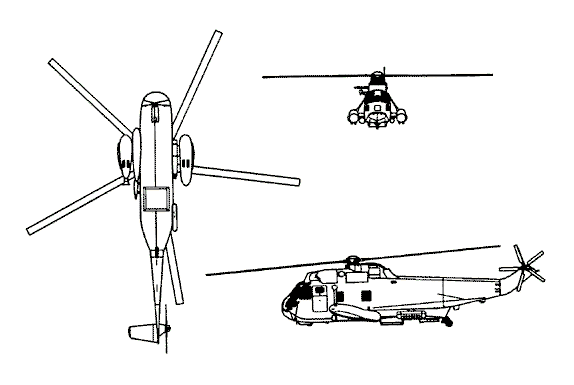| H-3 AIRCRAFT DESCRIPTION Contractor:
Sikorsky Aircraft,
Division of United Technologies
Type:
- General purpose,
single rotary wing, twin turbine powered
helicopter with emergency amphibious capabilities
- Available in
Anti-Submarine Warfare (SH-3H/D) and Utility
(UH-3H/SH-3G) configurations
Power Plant:
- SH-3H/UH-3H: Two
General Electric T-58-GE-402 turboshaft engines.
Each engine can produce approximately 1,500 shaft
horsepower. Standard since 1991.
- SH-3D: Two General
Electric T58-GE-10 turboshaft engines. Each
engine can produce approximately 1,400 shaft
horsepower.
- SH-3G: Two General
Electric T58-GE-8F turboshaft engines. Each
engine can produce approximately 1,250 shaft
horsepower.
Accommodations:
- SH-3H/D: Crew of four
(two pilots, two sensor operators) and up to
three passengers
- UH-3H/SH-3G: Can be
configured for up to 15 passengers in addition to
the aircrew
Performance:
- SH-3D/H helicopters
are capable of airspeeds up to 120 KIAS.
- Endurance varies
between 3.5 and 5.5 hours depending on the
mission.
- Maximum allowable
weight (SH-3H/UH-3H): 21,000 pounds
- Maximum allowable
weight (SH-3D): 20,500 pounds
- Maximum allowable
weight (SH-3G): 19,100 pounds
- Provisions for
carrying up to 6,000 pounds of external loads can
be added.
Countermeasures:
Not applicable
Armament:
- Two MK-46/44
anti-submarine torpedoes
- Various sonobouys and
pyrotechnic devices
Mission and
Capabilities:
- Class IB aircraft
designed for both shore- and ship-based
operations
- U.S. Navy missions
have included anti-submarine warfare, search and
rescue, and miscellaneous utility roles,
including limited external cargo capability.
- In the ASW role,
major sensors include: AQS-13 and AQS-18 dipping
sonar systems, various sonobuoys, and the ASQ-81
Magnetic Anomaly Detector. In addition, airborne
search and weather radar have been mounted on the
radar.
- Fully configured
instruments for all weather operations
- Capable of automatic
approach to a stabilized sustained hover
- The Teledyne AQS-123
TACNAV, a Doppler-based tactical navigation
system, is installed in the SH-3H and UH-3H.
- Provisions for
installation of a Global Position System (GPS)
are being added to some models.
Program Summary:
- The SH-3H completed
its last active duty deployment in 1995 and has
been replaced in the USN carrier force by the
SH-60.
- Eighty SH-3H
helicopters will be converted to the UH-3H model,
which are expected to remain in service with the
U.S. Navy in a utility role through 2010.
- The U.S. Naval
Reserves use six SH-3H helicopters in the ASW
mission.
- The SH-3H and UH-3H
have undergone a Service Life Extension Program
(SLEP), which included improvements to the
airframe, electrical wiring, main transmission,
and main rotor systems.
- SH-3D/G models and a
few out-of-service SH-3H aircraft have not
received the SLEP improvements.
- Significant aircrew
safety enhancements have been affected by the
addition of the Helicopter Emergency Egress
Lighting System (HEELS) and Crash-Resistant Crew
Seats.
- Installation of the
Inflight Blade Integrity System (IBIS) for the
in-service aircraft is planned during CY1996-97.
- Standard Depot Level
Maintenance (SDLM) capability was transitioned in
1995 from organic to civilian contract depot
support at PEMCO World Air Services, Dothan, AL.
- The H-3 is currently
operated by numerous foreign governments,
including: Spain, Egypt, Brazil, and Malaysia.
These countries have active Security Assistance
cases with the U.S. Navy for maintenance,
logistics, and engineering support.
H-3 TECHNICAL DATA:
External Dimensions
|
| Main rotor
diameter |
|
| Main rotor blade
chord |
|
| Tail rotor
diameter |
|
| Tail rotor blade
chord |
|
| Distance between
rotor centers |
|
| Wing span |
|
| Wing aspect ratio |
|
| Length: overall,
rotors turning |
|
| fuselage |
|
| Width overall |
|
| Height: to top of
rotor head |
|
| Overall Height |
|
| Ground clearance,
main rotor, turning |
|
| Elevator span |
|
| Width over skids |
|
Areas
|
| Main rotor blades
(each) |
|
| Tail rotor blades
(each) |
|
| Main rotor disc |
|
| Tail rotor disc |
|
| Vertical fin |
|
| Horizontal tail
surfaces |
|
Weights and Loadings
|
| Weight empty |
|
| Mission fuel load
(usable) |
|
| Maximum useful
load (fuel and disposable ordinance) |
|
| Maximum Take off
and landing weight |
|
| Maximum disc
loading |
|
| Maximum power
loading |
|
Performance :
|
| Never -exceed
speed (Vne) |
|
| Maximum level
speed at S/L |
|
| Rate of climb at
S/L, OEI |
|
| Service ceiling |
|
| Service ceiling,
OEI |
|
| Hovering ceiling |
- IGE
|
|
- OGE
|
|
| Range at S/L with
standard fuel, no reserves |
|
|




 The H-3 is a twin engine, all-weather helicopter.
The SH-3H model is used by the Navy Reserves to detect,
classify, track and destroy enemy submarines. It also
provides logistical support and a search and rescue
capability. The UH-3H model is utility configured for logistical support and search and rescue missions.
The VH-3A model supports the Executive Transport Mission.
The first version of this workhorse helicopter was flown more than 35 years ago. The Sea
King has been replaced by the SH-60F Sea Hawk helicopters as the anti-submarine warfare helicopter.
The transition was completed in the mid 1990s. The remaining Sea King helicopters have been
configured for logistical support and search and rescue missions.
The H-3 is a twin engine, all-weather helicopter.
The SH-3H model is used by the Navy Reserves to detect,
classify, track and destroy enemy submarines. It also
provides logistical support and a search and rescue
capability. The UH-3H model is utility configured for logistical support and search and rescue missions.
The VH-3A model supports the Executive Transport Mission.
The first version of this workhorse helicopter was flown more than 35 years ago. The Sea
King has been replaced by the SH-60F Sea Hawk helicopters as the anti-submarine warfare helicopter.
The transition was completed in the mid 1990s. The remaining Sea King helicopters have been
configured for logistical support and search and rescue missions.
